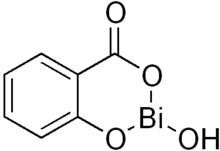Pepto-Bismol
 | |
| Clinical data | |
|---|---|
| AHFS/Drugs.com | Consumer Drug Information |
| License data | |
| Routes of administration | Oral |
| Legal status | |
| Legal status | |
| Identifiers | |
| |
| Chemical and physical data | |
| Formula | C7H5BiO4 |
| Molar mass | base: 361 gm/mol g·mol−1 |
| (verify) | |
Pepto-Bismol is an over-the-counter drug currently produced by the Procter and Gamble company in the United States of America, Canada and in United Kingdom, to treat minor digestive system upset. Its active ingredient is bismuth subsalicylate. The primary symptoms aided by Pepto-Bismol are nausea, heartburn, indigestion, upset stomach, diarrhea, and other temporary discomforts of the stomach and gastrointestinal tract.
Pepto-Bismol is made in chewable tablets[1] and swallowable caplets,[2] but is best known for its original formula which is a thick liquid. This original formula is a medium pink color with a strong wintergreen or cherry flavor.
Mechanism of action
Bismuth subsalicylate (the active ingredient in Pepto-Bismol) is used as an antidiarrheal and to treat some other gastro-intestinal diseases (oligodynamic effect, which relates to killing microbes with small doses of heavy metals).
The means by which this appears to work is still not well documented. It is thought to be some combination of:
- Retarding the expulsion of fluids into the digestive system by irritated tissues, by "coating" them.
- Reducing inflammation/irritation of stomach and intestinal lining
- Killing some bacteria that cause diarrhea. There is evidence that salicylic acid from hydrolysis of the drug is antimicrobial for E. coli.[3]
Side effects
Children are usually more sensitive to the effects of salicylates, especially if they have a fever or have lost large amounts of body fluid because of vomiting, diarrhea, or sweating.
The bismuth in this medicine may cause severe constipation in children. In addition, it can combine with trace amounts of sulfur in saliva and the gastrointestinal tract, blackening the user's tongue and stool. This condition is harmless and subsides within a few days.[4]
Children should not take medication with bismuth subsalicylate while recovering from influenza or chicken pox, as epidemiologic evidence points to an association between the use of salicylate-containing medications during certain viral infections and the onset of Reye's syndrome.[5][6] For the same reason, it is typically recommended that nursing mothers not use medication containing bismuth subsalicylate (such as Pepto-Bismol) because small amounts of the medication are excreted in breast milk and pose a theoretical risk of Reye's syndrome to nursing children.[7] Antacid preparations by suppressing acid mediated break down of proteins, leads to an elevated risk of developing food or drug allergies. This happens due to undigested proteins then passing into the gastrointestinal tract where sensitisation occurs. The aluminium content may also increase the risk of sensitisation to allergens.[8] Long-term use of Pepto-Bismol (greater than 6 weeks) may lead to toxicity due to accumulation of bismuth subsalicylate.[9]
History
Pepto-Bismol was invented in 1901 by a doctor in New York. It was originally sold as a remedy for infant diarrhea by Norwich Pharmacal Company under the name "Bismosal: Mixture Cholera Infantum". [10] It was renamed Pepto-Bismol in 1919. Norwich Eaton Pharmaceuticals was acquired by Procter and Gamble in 1982.
Disaster usage
Pepto-Bismol is utilized in the treatment of birds inundated by crude oil. For example, birds coated with oil from the Deepwater Horizon disaster received forced gastric infusions of Pepto-Bismol in efforts to rid their intestinal tracts of oil ingested while preening feathers of the contaminant. [11]
References
- ^ The trademark was extended to cover the tablets in 1973. Registration No. 0972198, November 6, 1973. http://tess2.uspto.gov/bin/showfield?f=doc&state=b8i462.2.2.
- ^ The capsules were introduced in 1983. Registration No. 1269605, March 13, 1984; cancelled July 16, 1990. http://tess2.uspto.gov/bin/showfield?f=doc&state=b8i462.2.1.
- ^ Sox TE, Olson CA (1989). "Binding and killing of bacteria by bismuth subsalicylate". Antimicrob. Agents Chemother. 33 (12): 2075–82. PMC 172824. PMID 2694949.
{{cite journal}}: Unknown parameter|month=ignored (help) - ^ http://www.pepto-bismol.com/pepto-bismol-faq.php#faq7
- ^ Aspirin or Salicylate-Containing Medications, reyessyndrome.org
- ^ http://www.drugs.com/cons/pepto-bismol.html
- ^ CDC warning about breastfeeding while taking bismuth subsalicylate compounds such as Pepto-Bismol
- ^ Pali-Schöll I, Jensen-Jarolim E (2011). "Anti-acid medication as a risk factor for food allergy". Allergy. 66 (4): 469–77. doi:10.1111/j.1398-9995.2010.02511.x. PMID 21121928.
{{cite journal}}: Unknown parameter|month=ignored (help) - ^ Gorbach, SL. (1990). "Bismuth therapy in gastrointestinal diseases". Gastroenterology. 99 (3): 863–75. PMID 2199292.
{{cite journal}}: Unknown parameter|month=ignored (help) - ^ Bierer, Douglas Ws. (Jan. - Feb.). "Bismuth Subsalicylate: History, Chemistry, and Safety". Reviews of Infectious Diseases. 12 (Supplement 1). Oxford University Press: S3–S8.
{{cite journal}}: Check date values in:|date=and|year=/|date=mismatch (help) - ^ Cain Burdeau and Holbrook Mohr. Deepwater Horizon drilling rig explosion. Associated Press. Posted: May 1, 2010.
